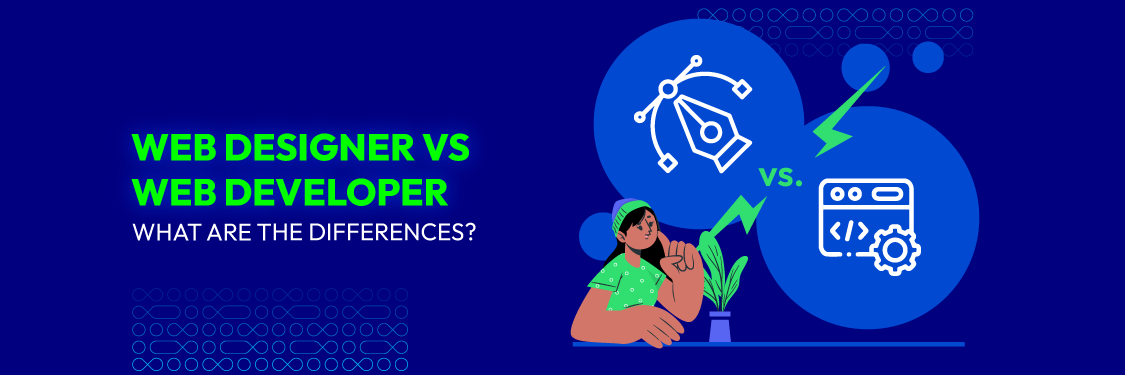Web Designer Vs Web Developer: What Are the Differences?
Summer Nguyen | 06-25-2024

In the fast-changing world of the internet, web designers and web developers are really important. They help create and manage websites and apps. Even though they do different things, both jobs are crucial. This article compares web designers and web developers to help people decide which path to take in this exciting field.
Table of Contents
About Web designers
What is a web designer?
A web designer is a person who creates an attractive and well-structured website. They select images, colors, fonts, and other elements to create an eye-catching website. Before creating a website, designers typically utilize software such as Adobe Photoshop, Sketch, or Figma to determine how it will look.

Web designers consider both aesthetics and user experience (UX) concepts to make a website user-friendly and provide visitors with a positive experience. They may work with web developers to ensure their concepts are implemented correctly and function properly across a range of browsers and devices.
In general, web designers are necessary to bring a website’s concept to life and provide users with an engaging and visually appealing online experience.
Roles of web designers:
- Visual design: Web designers create the visual components of a website, such as layout, color scheme, typography, and graphical elements.
- User experience (UX) design: They put a lot of effort into creating an intuitive, user-friendly interface that makes a good impression on visitors.
- Wireframing and prototyping: Web designers build wireframes and prototypes to visualize how a website will work and look before it is constructed.
- Branding and identity: They might also work on creating a website’s identity and branding to make sure it complements the client’s messaging and brand.
Types of web designers:
- User Interface (UI) Designer: UI designers are primarily concerned with the appearance and user experience of a website’s interface. They design elements like buttons, menus, forms, and other interactive components to enhance user involvement and experience.
- User Experience(UX) designer: To optimize the user experience when engaging with a website, UX designers put a lot of effort into understanding human desires and habits. They create wireframes, design user flows, and conduct user research to guarantee the website is easy to use and intuitive.
- Visual designer: Visual designers specialize in creating visually appealing website layouts, color schemes, typography, and graphics. They focus on the visual aspects of design to create a cohesive and visually appealing visual identity for the website.
About Web developers
What is a web developer?
The creation and upkeep of websites and online apps is the area of expertise for a professional web developer. They are responsible for writing the foundational code that powers and maintains the operation of the website.

Programming languages like HTML, CSS, and JavaScript are frequently used by web developers to create the layout, look, and feel of web pages. Additionally, they may use server-side languages for database management and user authentication, such as PHP, Python, or Ruby on Rails.
Web developers produce websites and web apps in close collaboration with web designers, project managers, and other website members from inception to completion. They are necessary to maintain the functionality, security, and most recent standards and technology of websites. They also oversee and maintain web pages.
Roles of web developers:
- Front-end development: Web developers’ primary focus is creating the code that manages a website’s interactive features and visual aspects. They create web pages’ structure, appearance, and functionality using languages like HTML, CSS, and JavaScript.
- Back-end development: They frequently write server-side code, which facilitates functions like database management and user and server request processing; this requires using Python, Ruby on Rails, or PHP.
- Full-stack development: Some developers can work on a web application’s websites since they are skilled in both front-end and back-end development.
- Performance optimization: Website performance is enhanced by web developers, assuring quick loads and economical resource usage.
- Security: They have security measures in place to defend websites from security risks like SQL injection, cross-site scripting (XSS), and cross-site request forgery (CSRF).
Types of web developers:
- Frontend developer: Frontend developers focus on the client side of web development, creating the user interface and experience for websites. They mostly work with HTML, CSS, and JavaScript to create dynamic and interesting websites that users can interact with directly in their web browsers.
- Backend developer: Backend developers handle the databases, logic, and server operations that underpin websites and online apps. They deal with databases, logic, and server operations. They specialize in this part of web development. They use frameworks like Django, Ruby on Rails, Laravel, Spring Boot, and Express.js. The languages they use include Python, Ruby, PHP, Java, and Node.js.
- Full-stack developer: Full-stack engineers can handle any aspect of web development because they are proficient in both frontend and backend programming. Their skill set is broad; in addition to designing user interfaces, they can also manage server infrastructure and databases.
Web Developer and Web Designer: A comprehensive comparison
Skills required
To thrive in their positions, web developers and designers need a combination of soft skills, creative ability, and technical capabilities.
Web developer skills
- Proficiency in programming languages: Web developers should know how to program in one or more of the following languages, depending on their area of experience: HTML, CSS, JavaScript, Python, Ruby, PHP, Java, C#, JavaScript (Node.js), SQL, NoSQL (MongoDB, Firebase)
- Frameworks and libraries: Familiarity with widely used frameworks and libraries related to their stack, including Angular, React, Vue.js, jQuery, Django, Ruby on Rails, Laravel, Spring Boot, and Express.js
- Responsive design: Ability to use CSS media queries and other approaches to construct websites that adjust and respond to different screen sizes.
- Debugging and problem-solving: Strong debugging skills to identify and resolve issues in code efficiently.
- API Integration: Experience integrating third-party APIs to add functionality to web applications.
- Testing and debugging: Familiarity with testing frameworks and debugging tools to ensure the quality and reliability of code.
Web designer skills
- Visual design principles: Understanding design principles such as layout, typography, color theory, and composition.
- UI/UX design: Knowledge of user interface (UI) and user experience (UX) design principles to create intuitive and user-friendly interfaces.
- Graphic design tools: Proficiency in graphic design tools like Adobe Photoshop, Illustrator, Sketch, or Figma for creating visual elements and mockups.
- Prototyping and wireframing: Ability to create wireframes and prototypes to visualize and iterate on design concepts.
- HTML and CSS: Basic understanding of HTML and CSS to implement designs and collaborate effectively with developers.

Tools used
To design, develop, and administer websites and web applications, web developers and designers employ a variety of tools. Here are some common tools used by each:
Web developers
- Integrated development environments (IDEs) and Text Editors (e.g., Visual Studio code, Sublime text)
- Version control systems (e.g., Git, GitHub)
- Frontend development tools (e.g., Browser developer tools, CSS Preprocessors, Frontend frameworks)
- Backend development tools (e.g., Server-side frameworks, Databases, API development tools)
- Testing and debugging tools (e.g., Testing frameworks, Debugging tools)
- Deployment and hosting platforms (e.g., AWS, Heroku, DigitalOcean)
Web designers
- Graphic design tools (e.g., Adobe Photoshop, Sketch, Figma)
- Prototyping and wireframing tools (e.g., Adobe XD, InVision, Balsamiq)
- Collaboration and project management tools (e.g., Slack, Trello, Asana)
- UI/UX design tools (e.g., Adobe XD, Sketch, Figma)
- Color and typography tools (e.g., Adobe Color, Google Fonts, Font Awesome)
Portfolios
Web designers and developers frequently use portfolios to display their work, showcasing their abilities, knowledge, and completed projects. Here’s what each might include in their portfolios:
Web developer portfolio
- Projects: Showcase developed websites or applications with descriptions and technologies used.
- Code samples: Provide snippets or links to GitHub repositories demonstrating coding skills.
- Technical skills: List proficiency in relevant languages, frameworks, and databases.
- Responsive design: Highlight projects with mobile-friendly and adaptable layouts.
- Collaboration: Mention teamwork and project management.
- Testimonials: Include client or colleague recommendations for credibility.
Web designer portfolio
- Design projects: Showcase websites, apps, and branding materials with descriptions.
- Visual skills: Highlight proficiency in graphic design, typography, and layout.
- UI/UX design: Show wireframes and prototypes to improve usability.
- Tools: List software proficiency like Adobe Creative Suite, Sketch, or Figma.
- Branding: Include logos and style guides demonstrating brand identity skills.
- Responsive design: Illustrate designs that adapt to different devices.
- Testimonials: Feature client endorsements for professionalism and creativity.
Salary
Web developers’ and designers’ incomes can differ based on factors like geography, experience, skill level, firm size, and industry demand.
Web developer salary
- Entry-level web developer: between $50,000 to $70,000 per year.
- Mid-level web developer: between $70,000 to $100,000 per year.
- Senior web developer: upwards of $100,000 to $150,000 yearly.
Web designer salary
- Entry-level web designer: between $40,000 and $60,000 per year.
- Mid-level web designer: between $60,000 to $80,000 per year.
- Senior web designer: upwards of $80,000 to $120,000 per year or more.
It’s crucial to remember that these wage ranges are estimates that may change depending on a person’s unique situation and the state of the market. Furthermore, incomes may vary among nations and geographical areas.
When to Hire Web Designer vs. Web Developer
Hire a web designer if:
- Your main focus is on the visual appeal and user experience (UX) of your website.
- You want a professional to create a visually stunning and engaging website that reflects your brand identity.
- You need help with designing the layout, navigation, and overall look and feel of your site.
- You’re revamping an existing website and want a fresh look without changing the functionality.
Hire a web developer if:
- You need a website with complex features or functionalities, such as an e-commerce store, a membership site, or a custom application.
- You want to ensure your website is mobile-friendly and responsive across different devices.
- You need someone to write code, integrate databases, or handle server-side scripting.
- You’re building a website from scratch and need someone to bring the design to life with coding.
In some cases, you might need both:
- If you’re creating a new website from scratch with a strong visual identity and complex functionalities, then you’ll likely need to hire both a web designer and a web developer.
- Some web professionals possess skills in both design and development, so you might find someone who can handle both aspects of your project.
Conclusion
The article above gives you a comprehensive overview of web designer vs web developer. Before choosing the right career, consider skills, interests, and aspirations. Both roles offer exciting opportunities for creativity, problem-solving, and continuous learning within the dynamic field of web development.





